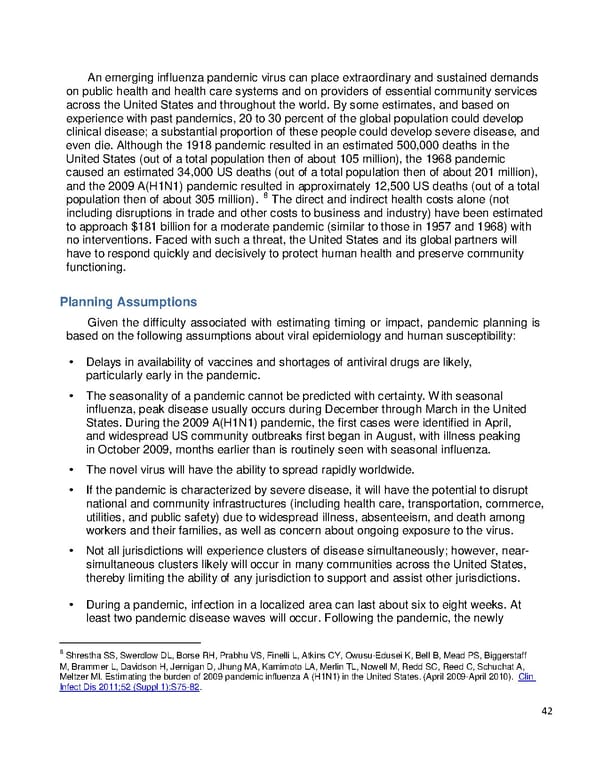An emerging influenza pandemic virus can place extraordinary and sustained demands on public health and health care systems and on providers of essential community services across the United States and throughout the world. By some estimates, and based on experience with past pandemics, 20 to 30 percent of the global population could develop clinical disease; a substantial proportion of these people could develop severe disease, and even die. Although the 1918 pandemic resulted in an estimated 500,000 deaths in the United States (out of a total population then of about 105 million), the 1968 pandemic caused an estimated 34,000 US deaths (out of a total population then of about 201 million), and the 2009 A(H1N1) pandemic resulted in approximately 12,500 US deaths (out of a total 8 population then of about 305 million). The direct and indirect health costs alone (not including disruptions in trade and other costs to business and industry) have been estimated to approach $181 billion for a moderate pandemic (similar to those in 1957 and 1968) with no interventions. Faced with such a threat, the United States and its global partners will have to respond quickly and decisively to protect human health and preserve community functioning. Planning Assumptions Given the difficulty associated with estimating timing or impact, pandemic planning is based on the following assumptions about viral epidemiology and human susceptibility: • Delays in availability of vaccines and shortages of antiviral drugs are likely, particularly early in the pandemic. • The seasonality of a pandemic cannot be predicted with certainty. With seasonal influenza, peak disease usually occurs during December through March in the United States. During the 2009 A(H1N1) pandemic, the first cases were identified in April, and widespread US community outbreaks first began in August, with illness peaking in October 2009, months earlier than is routinely seen with seasonal influenza. • The novel virus will have the ability to spread rapidly worldwide. • If the pandemic is characterized by severe disease, it will have the potential to disrupt national and community infrastructures (including health care, transportation, commerce, utilities, and public safety) due to widespread illness, absenteeism, and death among workers and their families, as well as concern about ongoing exposure to the virus. • Not all jurisdictions will experience clusters of disease simultaneously; however, near- simultaneous clusters likely will occur in many communities across the United States, thereby limiting the ability of any jurisdiction to support and assist other jurisdictions. • During a pandemic, infection in a localized area can last about six to eight weeks. At least two pandemic disease waves will occur. Following the pandemic, the newly 8 Shrestha SS, Swerdlow DL, Borse RH, Prabhu VS, Finelli L, Atkins CY, Owusu-Edusei K, Bell B, Mead PS, Biggerstaff M, Brammer L, Davidson H, Jernigan D, Jhung MA, Kamimoto LA, Merlin TL, Nowell M, Redd SC, Reed C, Schuchat A, Meltzer MI. Estimating the burden of 2009 pandemic influenza A (H1N1) in the United States. (April 2009-April 2010). Clin Infect Dis 2011;52 (Suppl 1):S75-82. 42
 Pandemic Influenza Plan Page 41 Page 43
Pandemic Influenza Plan Page 41 Page 43